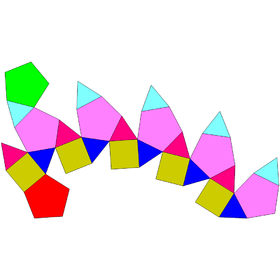Pentagonal orthocupolarotunda
| Pentagonal orthocupolarotunda | |
|---|---|
squares 2+5 pentagons | |
| Edges | 50 |
| Vertices | 25 |
| Vertex configuration | 10(3.4.3.5) 5(3.4.5.4) 2.5(3.5.3.5) |
| Symmetry group | C5v |
| Dual polyhedron | - |
| Properties | convex |
| Net | |
 | |
In geometry, the pentagonal orthocupolarotunda is one of the Johnson solids (J32). As the name suggests, it can be constructed by joining a pentagonal cupola (J5) and a pentagonal rotunda (J6) along their decagonal bases, matching the pentagonal faces. A 36-degree rotation of one of the halves before the joining yields a pentagonal gyrocupolarotunda (J33).
A
convex polyhedra that is composed of regular polygon faces but are not uniform polyhedra (that is, they are not Platonic solids, Archimedean solids, prisms, or antiprisms). They were named by Norman Johnson, who first listed these polyhedra in 1966.[1]
Formulae
The following
References
- Zbl 0132.14603.
- Wolfram Alpha. Retrieved July 24, 2010.


